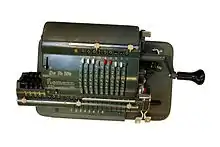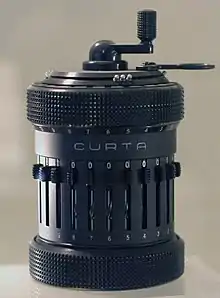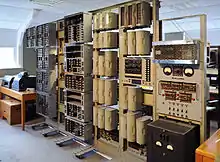Mechanical computer
A mechanical computer is built from mechanical components such as levers and gears, rather than electronic components. The most common examples are adding machines and mechanical counters, which use the turning of gears to increment output displays. More complex examples could carry out multiplication and division—Friden used a moving head which paused at each column—and even differential analysis. One model sold in the 1960s calculated square roots.

Mechanical computers can be either analog, using smooth mechanisms such as curved plates or slide rules for computations; or digital, which use gears.
Mechanical computers reached their zenith during World War II, when they formed the basis of complex bombsights including the Norden, as well as the similar devices for ship computations such as the US Torpedo Data Computer or British Admiralty Fire Control Table. Noteworthy are mechanical flight instruments for early spacecraft, which provided their computed output not in the form of digits, but through the displacements of indicator surfaces. From Yuri Gagarin's first manned spaceflight until 2002, every manned Soviet and Russian spacecraft Vostok, Voskhod and Soyuz was equipped with a Globus instrument showing the apparent movement of the Earth under the spacecraft through the displacement of a miniature terrestrial globe, plus latitude and longitude indicators.
Mechanical computers continued to be used into the 1960s, but were quickly replaced by electronic calculators, which—with cathode-ray tube output—emerged in the mid-1960s. The evolution culminated in the 1970s with the introduction of inexpensive handheld electronic calculators. The use of mechanical computers declined in the 1970s and was rare by the 1980s.
In 2016, NASA announced that its Automaton Rover for Extreme Environments program would use a mechanical computer to operate in the harsh environmental conditions found on Venus.[1]
Examples

- Antikythera mechanism, c. 100 BC – A mechanical astronomical clock.
- Cosmic Engine, 1092 – Su Song's hydro-mechanical astronomical clock tower invented during the Song dynasty, which featured the use of an early escapement mechanism applied to clockwork.[2][3][4][5]
- Castle clock, 1206 – Al-Jazari's castle clock, a hydropowered mechanical astronomical clock, was the earliest programmable analog computer.[6][7][8]
- Pascaline, 1642 – Blaise Pascal's arithmetic machine primarily intended as an adding machine which could add and subtract two numbers directly, as well as multiply and divide by repetition.
- Stepped Reckoner, 1672 – Gottfried Wilhelm Leibniz's mechanical calculator that could add, subtract, multiply, and divide.
- Difference Engine, 1822 – Charles Babbage's mechanical device to calculate polynomials.
- Analytical Engine, 1837 – A later Charles Babbage device that could be said to encapsulate most of the elements of modern computers.
- Ball-and-disk integrator, 1886 – William Thomson used it in his Harmonic Analyser to measure tide heights by calculating coefficients of a Fourier series.
- Percy Ludgate's 1909 Analytical Machine – The 2nd of only two mechanical Analytical Engines ever designed.
- Marchant Calculator, 1918 – Most advanced of the mechanical calculators. The key design was by Carl Friden.
- István Juhász Gamma-Juhász[9][10][11][12] (early 1930s)
- Kerrison Predictor ("late 1930s"?)
- Z1, 1938 (ready in 1941) – Konrad Zuse's mechanical calculator (although part imprecisions hindered its function)[13]
- Mark I Fire Control Computer, deployed by the United States Navy during World War II (1939 to 1945) and up to 1969 or later.
- Curta calculator, 1948
- Moniac, 1949 – An analog computer used to model or simulate the UK economy.
- Voskhod Spacecraft "Globus" IMP navigation instrument, early 1960s
- Digi-Comp I, 1963 – An educational 3-bit digital computer
- Digi-Comp II, mid 1960s – A rolling ball digital computer
- Automaton – Mechanical devices that, in some cases, can store data and perform calculations, and perform other complicated tasks.
- Turing Tumble, 2017– An educational Turing-complete computer partially inspired by the Digi-Comp II
Electro-mechanical computers

Early electrically powered computers constructed from switches and relay logic rather than vacuum tubes (thermionic valves) or transistors (from which later electronic computers were constructed) are classified as electro-mechanical computers. These varied greatly in design and capabilities, with some later units capable of floating point arithmetic. Some relay-based computers remained in service after the development of vacuum-tube computers, where their slower speed was compensated for by good reliability. Some models were built as duplicate processors to detect errors, or could detect errors and retry the instruction. A few models were sold commercially with multiple units produced, but many designs were experimental one-off productions.
| Name | Country | Year | Remarks | Reference |
|---|---|---|---|---|
| Automatic Relay Computer | UK | 1948 | The Booths, experimental | [14] |
| ARRA | Netherlands | 1952 | experimental | |
| BARK | Sweden | 1952 | experimental | |
| FACOM-100 | Japan | 1954 | Fujitsu commercial | [15] |
| FACOM-128 | Japan | 1956 | commercial | [16] |
| Harwell computer | UK | 1951 | later known as WITCH | |
| Harvard Mark I | United States | 1944 | (IBM Automatic Sequence Controlled Calculator) | |
| Harvard Mark II | USA | 1947 | ||
| IBM SSEC | USA | 1948 | ||
| Imperial College Computing Engine (ICCE) | UK | 1951 | Electro-mechanical[17] | [18][19][20] |
| Office of Naval Research ONR Relay Computer | USA | 1949 | 6-bit, drum storage, but electro-mechanical relay ALU based on Atlas, formerly Navy cryptology computer ABEL | [21][22][23][24] |
| OPREMA | East Germany | 1955 | Commercial use at Zeiss Optical in Jena | [25] |
| RVM-1 | Soviet Union | 1957 | Alexander Kronrod | [26] |
| SAPO | Czechoslovakia | 1957 | ||
| Simon | USA | 1950 | Hobbyist logic demonstrator magazine article | |
| Z2 | Germany | 1940 | Konrad Zuse | |
| Z3 | Germany | 1941 | Zuse | |
| Z4 | Germany | 1945 | Zuse | |
| Z5 | Germany | 1953 | Zuse | |
| Z11 | Germany | 1955 | Zuse, commercial | |
| Bell Labs Model I | USA | 1940 | George Stibitz, "Complex Number Calculator",450 relays and crossbar switches, demonstrated remote access 1940, used until 1948 | [27] |
| Bell Labs Model II | USA | 1943 | "Relay Interpolator", used for wartime work, shut down 1962 | [27] |
| Bell Labs Model III | USA | 1944 | "Ballistic Computer", used until 1949 | [27] |
| Bell Labs Model IV | USA | 1945 | Navy "Mark 22 Error Detector", used until 1961 | [27] |
| Bell Labs Model V | USA | 1946, 1947 | Two units delivered, general-purpose, built in trigonometric functions, floating-point arithmetic | [27] |
| Bell Labs Model VI | USA | 1949 | General purpose, simplified Model V with several enhancements | |
| Unnamed cryptanalysis multiplier | UK | 1937 | Turing | [28][29] |
| Relay Computer | USA | 2006 | Harry Porter's Relay Computer, demonstrator/hobby, but integrated circuit memory. | [30] |
See also
References
- Hall, Loura (2016-04-01). "Automaton Rover for Extreme Environments (AREE)". NASA. Retrieved 2017-08-29.
- Needham, Volume 4, Part 2, 445.
- Needham, Volume 4, Part 2, 448.
- Bodde, 140.
- Fry, 10.
- "Machines of the East". Ancient Discoveries. Season 3. Episode 10. History Channel. Retrieved 2008-09-07.
- Howard R. Turner (1997), Science in Medieval Islam: An Illustrated Introduction, p. 184, University of Texas Press, ISBN 0-292-78149-0
- Donald Routledge Hill, "Mechanical Engineering in the Medieval Near East", Scientific American, May 1991, pp. 64–9 (cf. Donald Routledge Hill, Mechanical Engineering Archived 2007-12-25 at the Wayback Machine)
- https://hal.inria.fr/hal-01526814/document
- Weibel, Peter (17 May 2005). Beyond Art: A Third Culture: A Comparative Study in Cultures, Art and Science in 20th Century Austria and Hungary. ISBN 9783211245620.
- https://live.warthunder.com/post/457384/en/
- Gander, Terry (30 April 2013). The Bofors Gun. ISBN 9781783462025.
- "Z3 from FOLDOC". foldoc.org. Retrieved 2020-07-02.
- Lavington, Simon Hugh (1980). Early British Computers: The Story of Vintage Computers and the People who Built Them. Manchester University Press. p. 62. ISBN 9780719008108.
- "Fujitsu Facom 100". Retrieved 2017-07-26.
- "FACOM 128A and 128B Relay Computers". Retrieved 2017-07-26.
- "Profile for Tony Brooker at the University of Essex". www.essex.ac.uk. Retrieved 2018-05-19.
- "From the Arithmometer to Electronic Arithmetic – 1998". Imperial College Video Archive Blog. Cited video fragment. 2016-05-06. From 38:15 to 38:32. Retrieved 2018-05-14.CS1 maint: others (link)
- "Relay Digital Computer, Imperial College, Univ. of London". Digital Computer Newsletter. 3 (1): 4. April 1951.
- Bowden, B. V. (ed.). "11. The Imperial College Computing Engine". Faster Than Thought. pp. 161–164 (103–105).
- Boslaugh, David L. (2003). When Computers Went to Sea: The Digitization of the United States Navy. John Wiley & Sons. pp. 95–96. ISBN 9780471472209.
- "The ONR Relay Computer". Digital Computer Newsletter. 4 (2): 2. April 1952.
- A survey of automatic digital computers. Office of Naval Research, Dept. of the Navy. 1953. p. 75.
- Wolf, J. Jay (1952). "The Office of Naval Research Relay Computer". Mathematics of Computation. 6 (40): 207–212. doi:10.1090/S0025-5718-1952-0050393-0. ISSN 0025-5718.
- Augustine, Dolores L. (2007). Red Prometheus: Engineering and Dictatorship in East Germany, 1945–1990. MIT Press. p. 134. ISBN 9780262012362.
- "Relay Computer RVM-1". Retrieved 2017-07-25.
- Belzer, Jack; Holzman, Albert G.; Kent, Allen (1976-03-01). Encyclopedia of Computer Science and Technology: Volume 3 – Ballistics Calculations to Box-Jenkins Approach to Time Series Analysis and Forecasting. CRC Press. pp. 197–200. ISBN 9780824722531.
- Teuscher, Christof (2004). Alan Turing: Life and Legacy of a Great Thinker. Springer Science & Business Media. p. 46. ISBN 9783540200208.
- Hodges, Andrew (2014-11-10). Alan Turing: The Enigma: The Book That Inspired the Film "The Imitation Game". Princeton University Press. pp. 175–177. ISBN 9781400865123.
- "Harry Porter's Relay Computer". Retrieved 2017-07-26.